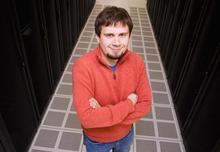Coarse-Grained DNA model

A simple coarse-grained model of single-stranded DNA (ssDNA) was developed, featuring only two sites per nucleotide that represent the centers of mass of the backbone and sugar/base groups. Interactions between sites are described using tabulated bonded potentials optimized to reproduce the solution structure of DNA observed in atomistic molecular dynamics simulations. Isotropic potentials describe nonbonded interactions, implicitly taking into account the solvent conditions to match the experimentally determined radius of gyration of ssDNA. The model reproduces experimentally measured force–extension dependence of an unstructured DNA strand across 2 orders of magnitude of the applied force. A complete description of the model was published in the Journal of Chemical Theory and Computation.
All required configuration files can be downloaded. To use the model, a custom version of NAMD must be compiled using a patch provided in the archive. For questions, contact Christopher Maffeo.

